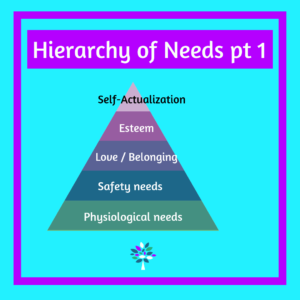Hierarchy of Needs

In 1943 Abraham Maslow proposed a theory of human needs in his paper, A Theory of Human Motivation. The above hierarchy (Maslow’s Hierarchy of Needs) is what he proposed and what I will be reviewing in more detail in this and following posts.
Maslow’s idea was that people’s motivation is driven by the lowest level of needs in the hierarchy. Therefore, a person’s physiological needs come before their safety needs, or their needs for belonging or self-actualization.
Physiological needs include the needs for food, water, sleep, clothing, and shelter. So, when people are on the streets, their primary motivation is going to be to meet their needs for the basics of shelter, food, etc.
It makes sense then, that these most basic needs are where motivation and drive start. And this is why we have housing first models for social services, meaning that these programs supply housing first before addressing other needs. This is because people cannot be reasonably expected to be working on their mental health or finding a job if they don’t have a roof over their head or know where their next meal is coming from.
This is a graphic representing Maslow’s hierarchy of needs. Previously I wrote about the most basic needs, the Physiological Needs. In this post, I am focusing on the second level of needs, the need for safety. Once a person’s physiological needs are relatively satisfied, then the next motivator of behavior is their safety needs.
In this context, safety needs refer to more than just physical safety, although that is certainly part of it. If a child is not safe in the home due to abuse or domestic violence, their energy is going to be on finding safety, and not on higher level needs such as belonging. If they grow up in an unsafe neighborhood, they may seek the relative safety of a gang.
Other aspects of safety include economic safety, this is related to job security, a sense that there is a stable source of income to meet the an individual or family’s needs. Those in the trans+ community are often unemployed or underemployed as they have difficulty finding places that are willing to hire them and often a review of work history is going to out them.
Emotional security is also a factor here. Even if a child is not being physically harmed, if they do not have emotional safety, they will seek to find this before attempting to meet any higher order needs. If it is not possible to get their emotional needs met, then one way of coping with this is by denying or shutting off these needs or numbing them with sex, drugs or alcohol.
And a final area in safety needs is health and well-being. If a person gets sick, can they feel secure in getting the medical attention and intervention that they need. For trans+ people this can be tricky as it may require exposure to transphobic or uninformed service providers. Many in the trans community have been denied health care due to their gender identity.
The third level on Maslow’s Hierarchy of Needs is the Love / Belonging level. According to Maslow humans have a need to feel a sense of belonging in their social groups – whether they are family groups, with intimate partner(s) or wider social groups, such as with clubs, schools, and sports.
This need for interpersonal belonging has more energy and drive to it at different points in our development. So, in young childhood this need for love might actually override the need for safety at times. This can be seen with children who attach to their abusive caregivers when the other parental figure is not available for attachment due to disinterest, depression, or absence.
This need for belonging is also more active in adolescence when kids move away from such a strong need to belong to family and start seeking belonging among peers. At this time, that need for belonging with peers can again overwhelm the need for safety, as can be seen in kids who join gangs.
Difficulties with developing a secure attachment given neglect or abuse in the home and lead to difficulties in adulthood with their ability to form and maintain relationships in general. That is at the heart of the attachment literature that I have reviewed in the past.
The fourth level in Maslow’s hierarchy of needs is the need for esteem. For Maslow, esteem referred to the need for recognition, status, and respect from others. This drive is often manifested in the hobbies one engaged in or the profession one chooses. Maslow considered the need for esteem from others the lower version of this need.
Maslow considered the need for self-esteem and self-respect to be the higher version of esteem needs. Sometimes a low self-esteem can lead to a fixation on finding fame or glory to make oneself feel esteemed and respected. However, while this might meet the need for the esteem of others, it does not fill the void left by low self-esteem and that is why achieving this type of esteem can feel hollow.
I think it is important to remember that this need to be esteemed by others can be normal and healthy. This need helps hold together the fabric of society. Often our behavior and choices are driven by what others will think and this helps maintain the social order. It is only when this need is elevated above the need for self-esteem that things get unhealthy and problematic.
The fifth and final level in Maslow’s hierarchy of needs is the self-actualization phase. This level is about living up to one’s full potential and achieving all one can. The way that this level is manifested depends on the individual’s goals or values. This is often about giving oneself to something greater, something outside the self.
This level is about finding and achieving meaning in life and often has an element of creativity to it. And again, this will be shaped by the person’s values. So, for some, the pinnacle of meaning and purpose in life might be to become a spouse or a parent. For others, it might be about creating their masterpiece artistically. For others still it might be about becoming a master of their craft, or making a difference to the society or world they are living in. It really is shaped by personal values.
Clearly this is a level at which few of us truly achieve, but it is a motivation that many of us use to spur on more learning, more practice and more effort to achieve that peak experience. And often the journey is much more important than the destination.










